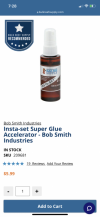grizfyrfyter
Guest
I heard about this a couple months ago from another reefer. I found a video from Tidal Gardens showing the technique and what rock structures they built with it.
I've used epoxy before, I didn't like it. I've used hydraulic cement before, I didn't like how long it took to cure and it took a couple hours to really solidify and I still had pieces fail. I used emarco 400 a lot, it takes a while to really harden and bond but it works well.
This method is hard within a minute and the bond is so strong, everytime I tried to break it, the rocks broke before the glue did.
I ordered a bottle of thin CA glue from gluemasters and broke up a bunch of rock that was in my garage. I also bought a 10lb bag of dry aragonite sand

The technique is to position your rocks together, put some glue on both pieces and immediately put sand on top of the glue. Put more glue on the sand and cover with glue again. Another layer of glue then another layer of sand. Let sit for 45 seconds and it's done. Rock hard bond.
The connections are visible but not nearly as much as with epoxy or cement.


Flip the rock over and do the other side.
I was able to do this rock work for my 100 gal tank in about 2 hours with less than 8oz of glue.

I have also tried this with a few different brands of glue and it works fine. They didn't dry as fast, the longest I had to wait was about 5 min for a single connection before it was solid but that's still better than any other option. The key is you need THIN glue. Medium or Thick glue just doesn't work.
*
Also, wear gloves. Not latex or nitrile gloves, they will just tear and leave pieces on the rocks. Wear light duty work gloves, heavy cleaning gloves might work.
You will want to do this in a well ventilated area unless you like killing braincells (though, there are much better way to accomplish this).
*
I've used epoxy before, I didn't like it. I've used hydraulic cement before, I didn't like how long it took to cure and it took a couple hours to really solidify and I still had pieces fail. I used emarco 400 a lot, it takes a while to really harden and bond but it works well.
This method is hard within a minute and the bond is so strong, everytime I tried to break it, the rocks broke before the glue did.
I ordered a bottle of thin CA glue from gluemasters and broke up a bunch of rock that was in my garage. I also bought a 10lb bag of dry aragonite sand
The technique is to position your rocks together, put some glue on both pieces and immediately put sand on top of the glue. Put more glue on the sand and cover with glue again. Another layer of glue then another layer of sand. Let sit for 45 seconds and it's done. Rock hard bond.
The connections are visible but not nearly as much as with epoxy or cement.
Flip the rock over and do the other side.
I was able to do this rock work for my 100 gal tank in about 2 hours with less than 8oz of glue.
I have also tried this with a few different brands of glue and it works fine. They didn't dry as fast, the longest I had to wait was about 5 min for a single connection before it was solid but that's still better than any other option. The key is you need THIN glue. Medium or Thick glue just doesn't work.
*
Also, wear gloves. Not latex or nitrile gloves, they will just tear and leave pieces on the rocks. Wear light duty work gloves, heavy cleaning gloves might work.
You will want to do this in a well ventilated area unless you like killing braincells (though, there are much better way to accomplish this).
*
Last edited:


